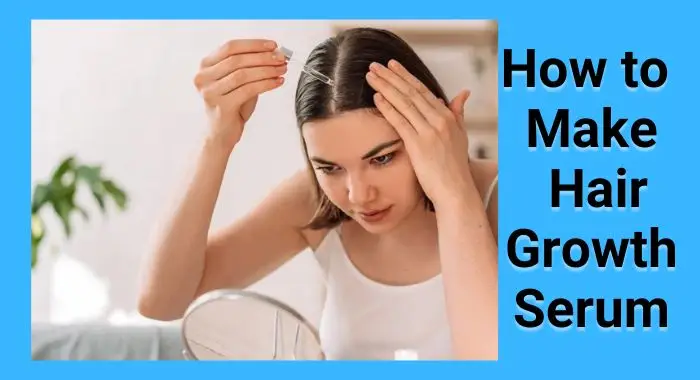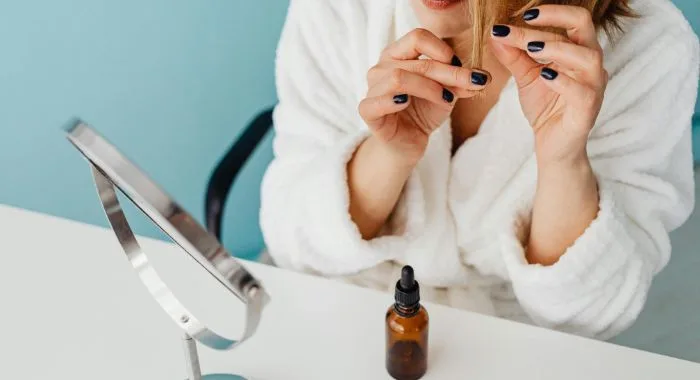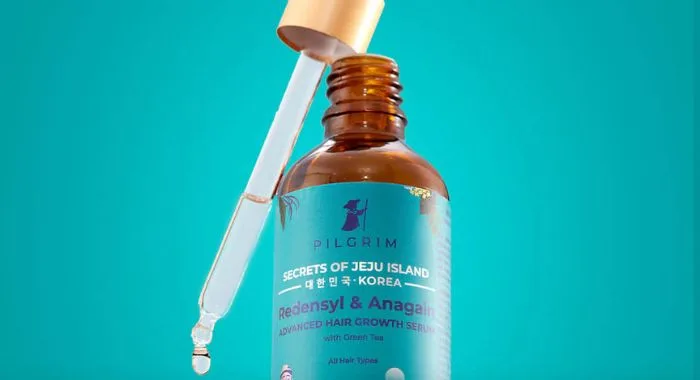As an Amazon Associate, I earn from qualifying purchases
Hair growth serum not only gives you control over the ingredients but also ensures you’re using natural, effective components tailored to your unique hair needs. Packed with essential nutrients, carrier oils, and plant-based extracts, a DIY serum can help nourish your scalp, strengthen hair follicles, and promote faster, healthier hair growth.
We describe in this post, that you’ll learn step-by-step how to make a hair growth serum at home using simple, accessible ingredients. Whether you’re dealing with hair thinning, breakage, or slow growth, this natural solution is a great way to give your hair the care it deserves.

What Is A Hair Serum?
Hair serum is a lightweight liquid product formulated to enhance the texture, appearance, and overall vitality of your hair. Unlike traditional hair oils, serums are typically silicone or oil-based formulations that coat the surface of your hair strands rather than penetrating deeply into the scalp.
This makes them excellent for adding shine, reducing frizz, and protecting hair from damage caused by heat styling or environmental factors like pollution and humidity. Hair serums come in various types, each tailored to specific needs, such as smoothing, volumizing, or promoting growth.
Benefits of DIY Hair Growth Serum
DIY serums are free from harmful chemicals, synthetic fragrances, and preservatives, ensuring your hair and scalp are treated with gentle, natural ingredients. They are also cost-effective, as many of the essential oils and carrier oils used can be purchased affordably and last for multiple batches.
Additionally, these homemade serums often include nutrient-rich ingredients like argan oil, castor oil, and rosemary essential oil, which are known to nourish hair follicles, stimulate growth, and improve overall hair health. By making your serum, you can prioritize quality, reduce exposure to toxins, and enjoy the satisfaction of creating a product tailored just for you.
How To Make A Hair Serum At Home?
To craft a nourishing hair serum at home, combine equal parts of coconut oil and almond oil. Gently warm the mixture to enhance its absorption. Apply the warm serum generously to your hair, concentrating on the mid-lengths and ends where it’s most needed. Leave the serum on for 20-30 minutes, allowing its moisturizing properties to penetrate your hair shafts.
Afterward, rinse your hair thoroughly with a gentle shampoo to remove any excess oil. This DIY serum can help revitalize dry, damaged hair, leaving it soft, silky, and lustrous.

Essential Ingredients for Hair Growth Serum
The effectiveness of a hair growth serum lies in its carefully selected ingredients, each offering unique benefits to promote healthy, luscious hair.
Carrier oils like castor oil, coconut oil, and jojoba oil form the base, delivering deep nourishment to the scalp and hair follicles while hydrating and strengthening strands.
Adding essential oils, such as rosemary, peppermint, and lavender, further enhances the serum’s effectiveness by stimulating blood circulation, reducing hair loss, and soothing the scalp. Nutrient-rich additives like vitamin E oil and aloe vera gel provide antioxidants and hydration, repairing damage and creating an optimal environment for growth.
Optional ingredients, such as biotin, argan oil, or even onion extract, can be included to target specific hair concerns like thinning or breakage.
Together, these natural components work synergistically to create a potent serum that supports hair growth, improves scalp health, and restores shine and vitality to your hair.
DIY Hair Serum Recipe For Hair Growth
Start with a base of 2 tablespoons of castor oil for its thick, nutrient-rich properties that strengthen hair follicles and stimulate growth. Add 1 tablespoon of coconut oil for deep hydration and to reduce breakage. Next, incorporate 5 drops of rosemary essential oil, known for enhancing scalp circulation, and 5 drops of peppermint essential oil for its invigorating and stimulating effects.
For additional nourishment, mix in 1 teaspoon of vitamin E oil to repair damaged strands and protect against oxidative stress. If desired, you can include 1 teaspoon of aloe vera gel to soothe the scalp and add moisture. Combine all the ingredients in a small, clean glass bottle with a dropper, and shake well to blend.
Apply a few drops to your scalp and massage gently, ensuring even distribution. Use this serum 2-3 times a week for best results, and enjoy healthier, stronger, and longer hair.
Precautions When Selecting Ingredients
Choosing the right ingredients for a hair growth serum is crucial to ensure its safety and effectiveness. Always opt for high-quality, organic oils and extracts to avoid contaminants that could irritate the scalp or harm your hair. Conduct a patch test on a small area of skin before using new ingredients, especially essential oils, to check for allergic reactions or sensitivities.
By carefully selecting and testing your ingredients, you can create a serum that is both safe and effective for promoting hair growth.
Customizing Your Hair Growth Serum
One of the greatest benefits of making your own hair growth serum is the ability to customize it to suit your specific hair type and needs. For individuals with oily hair, opt for lighter carrier oils like jojoba or grapeseed oil to avoid weighing down your strands. If you have dry or brittle hair, incorporate hydrating oils like argan or avocado oil for extra moisture.
Essential oils can also be tailored—use rosemary and peppermint oils for stimulating growth, tea tree oil to address dandruff or scalp issues, or lavender oil for soothing and balancing properties. For additional benefits, consider adding aloe vera gel to calm the scalp or biotin for strengthening hair.
How to Use Hair Growth Serum Effectively
Start by applying a few drops directly to your scalp, focusing on areas where hair thinning or breakage is most noticeable. Use your fingertips to gently massage the serum into your scalp in circular motions for 5-10 minutes; this stimulates blood flow and enhances absorption of the nutrients.
Avoid applying too much product, as it can leave your scalp feeling greasy or weighed down. For best results, use the serum 2-3 times a week, preferably at night, to allow the ingredients to work while you sleep.
Storage and Shelf Life
Always store the serum in a clean, dark glass bottle to protect it from light and heat, which can degrade the potency of natural oils and essential ingredients. Keep the bottle tightly sealed and place it in a cool, dry location, away from direct sunlight or moisture.
The shelf life of your serum depends on the freshness of the ingredients used; typically, it can last up to 3-6 months if stored correctly. To extend its life, you can add a natural preservative like vitamin E oil, which helps prevent oxidation.
Common Mistakes to Avoid
When using or making a hair growth serum, avoiding common mistakes is essential to achieve the desired results. One frequent error is overusing the serum; applying too much can leave your scalp greasy and clogged pores, potentially leading to buildup or irritation. Another mistake is neglecting to patch-test new ingredients, which can result in allergic reactions or sensitivities.
Additionally, failing to match the serum’s ingredients to your hair type can lead to imbalances—for example, using heavy oils on oily hair may cause excessive greasiness.
Finally, improper storage, such as exposing the serum to sunlight or heat, can reduce its potency. By being mindful of these pitfalls, you can ensure your serum is safe, effective, and tailored to support healthy hair growth.
Testimonials and Success Stories

Credit: Discover Pilgrim
Many individuals who have incorporated DIY hair growth serums into their routines have experienced transformative results.
For instance, Sarah, a 35-year-old mother, shared how her homemade serum of castor oil, coconut oil, and rosemary essential oil helped restore her postpartum hair loss within a few months of consistent use.
Similarly, David, a 28-year-old student, reported significant improvement in hair thickness after customizing his serum with jojoba oil and peppermint essential oil to suit his oily scalp.
Another success story comes from Priya, who used her serum infused with aloe vera gel and vitamin E to combat dandruff and promote stronger hair growth.
These stories highlight the power of natural ingredients and tailored formulations in addressing various hair concerns.
FAQ Of Hair Growth Serum
Quest: Are there any side effects of using essential oils in hair serums?
Ans: Essential oils are potent and may irritate if not diluted properly. Always conduct a patch test and follow recommended dilution ratios.
Quest: Can I store my serum in a plastic container?
Ans: It’s better to use a dark glass bottle to preserve the serum’s potency and prevent reactions with the plastic.
Quest: Do I need to wash off the serum after application?
Ans: It depends on your preference. You can leave the serum on overnight or rinse it out after 30 minutes to an hour.
Conclusion
You should remember that creating your hair growth serum is a simple, cost-effective, and natural way to promote healthier, stronger, and longer hair. By using high-quality carrier oils, essential oils, and other nourishing ingredients, you can customize a formula that suits your hair type and addresses specific concerns like thinning, dryness, or breakage.
Unlike store-bought products, a DIY serum gives you complete control over the ingredients, ensuring your hair is free from harsh chemicals. Regular use, paired with a healthy hair care routine, can lead to noticeable results over time.
Whether you’re new to DIY hair care or an experienced enthusiast, making your hair growth serum is a rewarding step toward achieving the hair of your dreams. Start today and let your hair thrive naturally! We hope that this blog post is very helpful for your hair growth.
As an Amazon Associate, I earn from qualifying purchases
